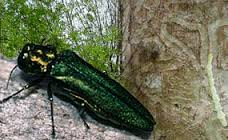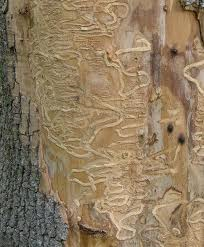
(Edited March 12 with budget information)
Emerald ash borer has been discussed at meetings of the Greene County supervisors and at least two city councils in the last two years, but aside from treating two large ash trees on the courthouse grounds, little has been done.
The problem may be taken more seriously this spring, as emerald ash borer has been found in Greene County, according to the Iowa Department of Natural Resources.
The DNR reported March 10 that EAB has been found in Greene County east of Grand Junction, and in Wayne County north of Corydon. Both locations were in rural areas. EAB attacks and decimates ash trees. It has now been identified in 43 Iowa counties.
Last May the Jefferson city council heard from DNR forester Jason Walker that Jefferson has 253 ash trees as street trees. None of them showed any signs of EAB infestation, but Walker recommended the city be proactive in removing ash trees and replacing them with other species in advance of EAB reaching Jefferson.
City public works director Dave Morlan said then he would like to see an additional $25,000 to $40,000 in the next fiscal year budget to begin removing the trees. The FY18 budget includes an additional $7,000 for that purpose.
The DNR encourages homeowners and people dealing with trees as a profession to report possibly infected trees.

The adult beetle is metallic green in color and measures approximately one-half inch long and can be noticed during the summer months. The larvae burrow through the inner layer of bark, eating away at the vascular tissue which supplies nutrients to the tree. Starved trees usually die within two to four years.
EAB-infested ash trees display canopy dieback beginning at the top of the tree and progressing downwards, S-shaped feeding galleries under dead or splitting bark, D-shaped exit holes, water
sprouts (along the trunk and main branches), and increased bark damage by woodpeckers.
At this calendar date, the window for all preventive treatments has closed. If a landowner is interested in protecting a valuable and healthy ash tree within 15 miles of a known infestation, he or she should have landscape and tree service companies bid on work, review the bids, and treat beginning spring 2017 (after mid- April).
A federal quarantine, enforced by the U.S. Department of Agriculture, remains in effect and restricts the movement of all hardwood firewood and ash articles out of Iowa into non-quarantined areas of other states. To help reduce people from unknowingly transporting EAB and other destructive tree-killing pests, Iowan’s are strongly encouraged to use locally sourced firewood.
The Iowa EAB Team provides EAB diagnostic assistance to landowners and includes officials from Iowa Department of Agriculture and Land Stewardship (IDALS), Iowa State University Extension and Outreach, the Iowa Department of Natural Resources (DNR), USDA Animal Plant Health Inspection Service and the USDA Forest Service. Anyone who suspects an infested ash tree in a county not known to have EAB is urged to contact the Iowa EAB Team.
Additional information, maps, and photos of EAB are available at www.IowaTreePests.com.
